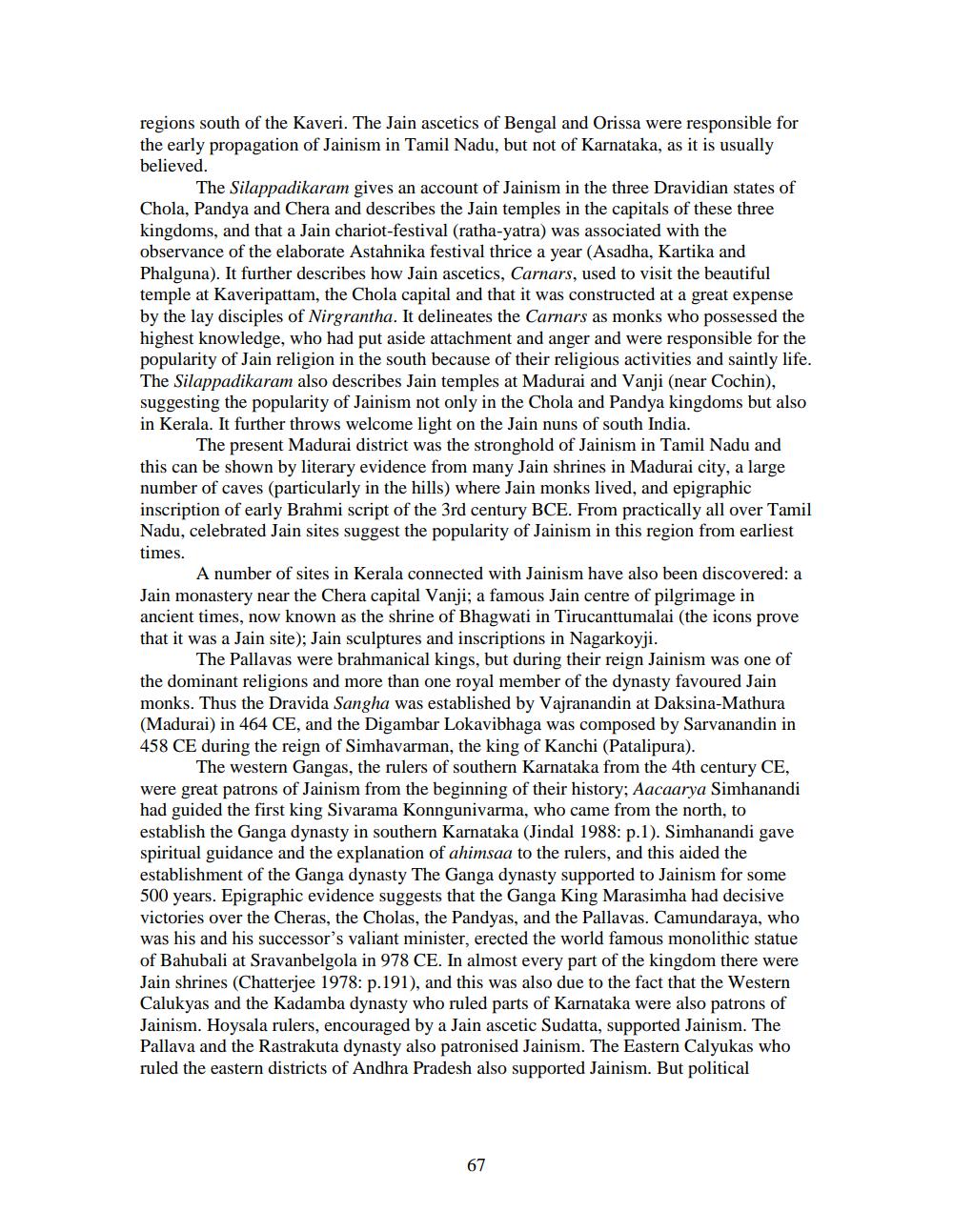________________
regions south of the Kaveri. The Jain ascetics of Bengal and Orissa were responsible for the early propagation of Jainism in Tamil Nadu, but not of Karnataka, as it is usually believed.
The Silappadikaram gives an account of Jainism in the three Dravidian states of Chola, Pandya and Chera and describes the Jain temples in the capitals of these three kingdoms, and that a Jain chariot-festival (ratha-yatra) was associated with the observance of the elaborate Astahnika festival thrice a year (Asadha, Kartika and Phalguna). It further describes how Jain ascetics, Carnars, used to visit the beautiful temple at Kaveripattam, the Chola capital and that it was constructed at a great expense by the lay disciples of Nirgrantha. It delineates the Carnars as monks who possessed the highest knowledge, who had put aside attachment and anger and were responsible for the popularity of Jain religion in the south because of their religious activities and saintly life. The Silappadikaram also describes Jain temples at Madurai and Vanji (near Cochin), suggesting the popularity of Jainism not only in the Chola and Pandya kingdoms but also in Kerala. It further throws welcome light on the Jain nuns of south India.
The present Madurai district was the stronghold of Jainism in Tamil Nadu and this can be shown by literary evidence from many Jain shrines in Madurai city, a large number of caves (particularly in the hills) where Jain monks lived, and epigraphic inscription of early Brahmi script of the 3rd century BCE. From practically all over Tamil Nadu, celebrated Jain sites suggest the popularity of Jainism in this region from earliest times.
A number of sites in Kerala connected with Jainism have also been discovered: a Jain monastery near the Chera capital Vanji; a famous Jain centre of pilgrimage in ancient times, now known as the shrine of Bhagwati in Tirucanttumalai (the icons prove that it was a Jain site); Jain sculptures and inscriptions in Nagarkoyji.
The Pallavas were brahmanical kings, but during their reign Jainism was one of the dominant religions and more than one royal member of the dynasty favoured Jain monks. Thus the Dravida Sangha was established by Vajranandin at Daksina-Mathura (Madurai) in 464 CE, and the Digambar Lokavibhaga was composed by Sarvanandin in 458 CE during the reign of Simhavarman, the king of Kanchi (Patalipura).
The western Gangas, the rulers of southern Karnataka from the 4th century CE, were great patrons of Jainism from the beginning of their history; Aacaarya Simhanandi had guided the first king Sivarama Konngunivarma, who came from the north, to establish the Ganga dynasty in southern Karnataka (Jindal 1988: p.1). Simhanandi gave spiritual guidance and the explanation of ahimsaa to the rulers, and this aided the establishment of the Ganga dynasty The Ganga dynasty supported to Jainism for some 500 years. Epigraphic evidence suggests that the Ganga King Marasimha had decisive victories over the Cheras, the Cholas, the Pandyas, and the Pallavas. Camundaraya, who was his and his successor's valiant minister, erected the world famous monolithic statue of Bahubali at Sravanbelgola in 978 CE. In almost every part of the kingdom there were Jain shrines (Chatterjee 1978: p.191), and this was also due to the fact that the Western Calukyas and the Kadamba dynasty who ruled parts of Karnataka were also patrons of Jainism. Hoysala rulers, encouraged by a Jain ascetic Sudatta, supported Jainism. The Pallava and the Rastrakuta dynasty also patronised Jainism. The Eastern Calyukas who ruled the eastern districts of Andhra Pradesh also supported Jainism. But political
67




